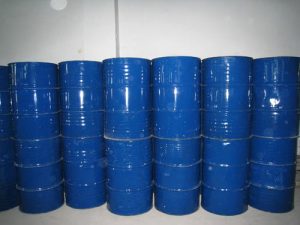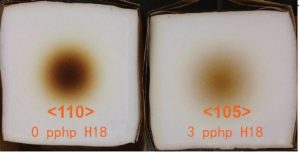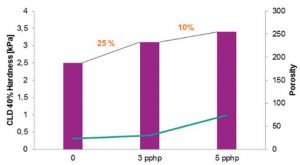Overview:
Product Name: Polyurethane elastomer environmental protection catalyst NT CAT E-129
Alias: polyurethane elastomer environmental protection catalyst, elastomer environmental protection catalyst, environmental protection catalyst, elastomer catalyst, elastomer catalyst NT CAT E-129
Product description: It has a special smell, is insoluble in water, and easily soluble in general polyurethane raw materials such as polyether and polyester polyol.
Character description:
The appearance of this product is light yellow transparent liquid, color (APHA) ?50; density 1.17g/cm3 (25 ?), viscosity 125mPa.s (25 ?), flash point 127 ?; has a special smell, insoluble in water, Easily soluble in general polyurethane raw materials such as polyether, polyester polyol, etc.
This product does not contain polybrominated biphenyls, polybrominated diphenyl ethers, lead, mercury, cadmium, etc. restricted by RoHS regulations, and does not contain nine types of organic tin compounds such as octyltin, butyltin, phenyltin, etc. Using the polyurethane material synthesized by this product can Adopted strict environmental protection regulations such as the United States and the European Union. In some areas of polyurethane, it is a substitute for eliminating traditional organic mercury, lead and other catalysts.
Product Features:
This product is developed to meet the requirements of products in the polyurethane CASE field (especially for polyurethane elastomers) without bubbles. It is completely different from commonly used amine tin catalysts. It has its own unique water suppression function, which can effectively shield the trace moisture and isocyanate contained in the polyurethane raw materials. Reaction to avoid the resulting CO2 bubbles (polyether polyol can be used without high-temperature vacuum dehydration), even in wet and rainy weather, it can effectively avoid the phenomenon of multiple bubbles, cracking, bulging, peeling, etc. Very similar to organic mercury.
The unique catalytic function of this product has a longer operating time than other products in this series, ensuring that the combined material maintains the original low viscosity and good fluidity before stirring evenly. This is very useful for reducing bubbles caused by mixing and quickly filling the mold cavity. Important; when the temperature in the system reaches 40 ?, the super catalytic effect of this product starts to appear, which can make the polyurethane composition reach the strength required for demolding within 20 minutes (or even shorter) after the mixing is completed, even without the need Subsequent heating and vulcanization have typical low energy consumption and high efficiency.
Application areas:
NT CAT E-129 has a good delay effect in this series of catalysts and has excellent hydrolysis resistance. When the temperature of the material is lower than 40?, the catalytic activity is very low. When the temperature of the material reaches 40?, its catalytic activity begins to appear. When the temperature reaches 50 ?, its catalytic activity increases rapidly, and when the temperature reaches 110 ?, its catalytic activity is stronger than ordinary organotin and bismuth on the market. NT CAT E-129 is very suitable for the combination of DETDA (E-100) as a curing agent, such as the combination of transparent ** shoe pulley and semi-polyurea, which has a longer pot life than other catalysts. To meet the needs of mold filling, it can produce skateboard wheels with hardness over 92A, shock absorbers and large products.
NT CAT E-129 is used in the MDI system using alcohol as a curing agent combination. It is characterized by a gentle reaction temperature rise curve and a smaller shrinkage than ordinary tin catalysts.
This product can be widely used in the production of polyurethane CASE field, single- and double-component sealants, coatings, adhesives, etc., used in aliphatic isocyanate, will not make the product yellow.
Instructions for use:
When using this product, it is recommended to add the polyol (Polyol, P material) component, and it is good to add it after vacuum degassing and before sealing, and stir it evenly. It can also be added to the isocyanate (ISO, I material) component, but it may be dangerous in the gel tank due to some raw materials, so please perform the suitability test first. The amount used is related to the product system and hardness. The general amount is 0.5 to 1‰ of the weight of the P material. Because different products have different environmental requirements, users are advised to do actual testing according to relevant standards.
Shelf life:
The unopened shelf life is 12 months.

Elastomer environmental protection catalyst NT CAT E-129 elastomer environmental protection catalyst environmental protection catalyst elastomer catalyst
Storage and transportation:
Should be sealed and stored in a dry, cool and ventilated warehouse
package:
200KG/drum Storage: It is recommended to store in a dry and cool area with proper ventilation. After the original packaging, please fasten the packaging cover as soon as possible to prevent the water and other substances from mixing into the product and affecting its performance. Store in a cool, dry place, keep the container sealed and avoid contact with oxides. Do not breathe dust, avoid skin and mucous membrane contact. Smoking, eating and drinking are prohibited in the workplace. After work, shower and change clothes. Store contaminated clothing separately and wash it before reuse. Maintain good hygiene habits. The company recommends that all polyurethane catalysts be stored in a dry, cool and properly ventilated place. All storage containers must be well sealed to avoid contact with water or other influential substances, because this may change the performance of the product in use. The storage temperature is 10°C to 30°C. Lower or higher temperatures are not suitable and should be avoided as much as possible.



